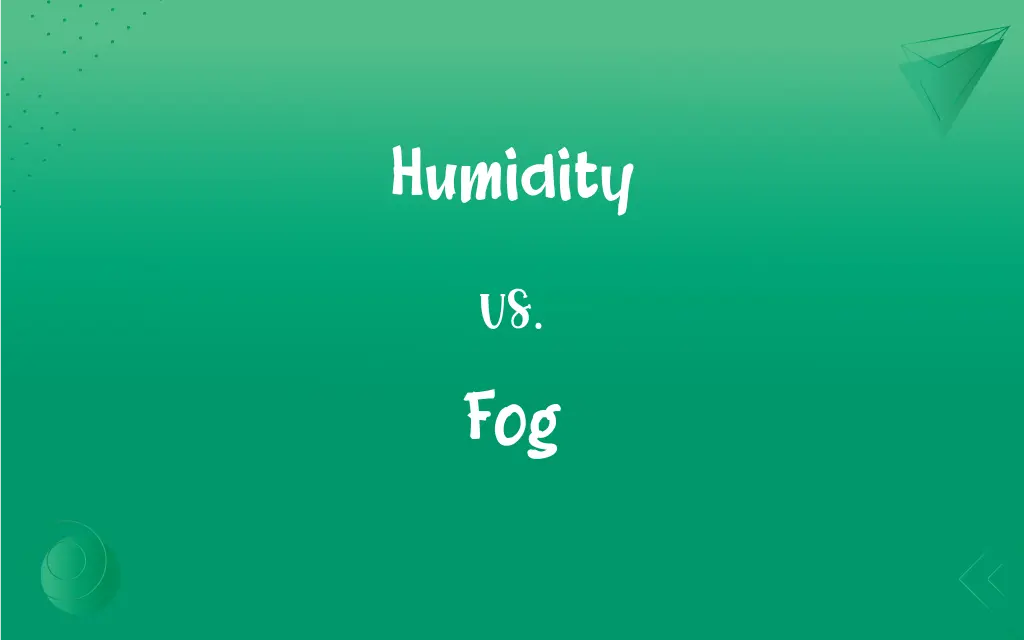Humidity vs. Fog: What's the Difference?
Edited by Aimie Carlson || By Janet White || Updated on November 12, 2023
Humidity is the amount of water vapor in the air, while fog is a cloud at ground level made up of tiny water droplets.

Key Differences
Humidity refers to the concentration of water vapor present in the air. It is a measure of the atmosphere's moisture content and can occur in any temperature. Fog, on the other hand, is a specific weather phenomenon where tiny water droplets are suspended in the air close to the Earth's surface, often reducing visibility. While humidity is invisible, fog is a visible manifestation of moisture in the air.
The level of humidity in the air can vary widely, from dry conditions with low humidity to oppressive environments with high humidity. Fog occurs when the humidity near the ground reaches 100%, causing the air to become saturated and the water vapor to condense into tiny droplets. Therefore, while humidity is a constant presence in the air, fog is a conditional occurrence dependent on specific humidity levels.
Humidity is often measured using devices like hygrometers, which indicate the percentage of moisture in the air. Fog formation, in contrast, is influenced by factors like temperature, geography, and the presence of water bodies. While humidity is a general term that doesn't necessarily imply visibility issues, fog is specifically associated with reduced visibility and can impact activities like driving or flying.
In terms of comfort, high humidity levels can make temperatures feel warmer than they are, as the body's ability to cool itself through sweat is hindered. Fog, conversely, often creates a cool, damp atmosphere, and its presence can signify specific weather patterns or changes, such as the transition from night to day when ground temperatures cool.
Humidity is a critical factor in weather forecasts and climatic studies, indicating the amount of moisture air can hold at a given temperature. Fog, while also important in weather prediction, is more localized and transient, often associated with specific locations like coastal areas or valleys.
ADVERTISEMENT
Comparison Chart
Definition
Amount of water vapor in the air
A cloud at ground level made of water droplets
Measurement
Measured as a percentage
Not measured, but observed
Visibility Impact
Invisible
Reduces visibility significantly
Formation
Can be present in any atmospheric condition
Forms when air is fully saturated with moisture
Weather Implication
Indicates moisture content of the air
Indicates localized saturation and cooling of air
ADVERTISEMENT
Humidity and Fog Definitions
Humidity
It represents the amount of moisture in the air.
The high humidity made the room feel warmer than it actually was.
Fog
It consists of tiny water droplets suspended in the air.
The fog was so dense that it made driving conditions hazardous.
Humidity
Humidity is the concentration of water vapor in the atmosphere.
The humidity was so high that the air felt thick and heavy.
Fog
Fog is a cloud that forms at the Earth's surface.
The valley was covered in a thick blanket of fog this morning.
Humidity
Humidity is a variable in weather that affects evaporation and condensation rates.
The high humidity slowed down the evaporation of the puddles from last night's rain.
Fog
It forms when air becomes saturated and cools to its dew point.
The fog usually forms over the river when cool and warm air mix.
Humidity
Humidity is the measure of the wetness or dryness of the air.
With the humidity low, the desert air felt extremely dry.
Fog
Fog is a visible weather phenomenon reducing visibility.
As the fog rolled in, the distant buildings disappeared from view.
Humidity
It's a key factor in determining comfort levels in various climates.
The humidity levels today are perfect for a day at the beach.
Fog
Fog is often associated with cool, damp conditions.
The morning jog was eerie and quiet in the dense fog.
Humidity
Dampness, especially of the air.
Fog
Condensed water vapor in cloudlike masses lying close to the ground and limiting visibility.
Humidity
Relative humidity.
Fog
An obscuring haze, as of atmospheric dust or smoke.
Humidity
Dampness, especially that of the air.
Fog
A mist or film clouding a surface, as of a window, lens, or mirror.
Humidity
The amount of water vapour in the air.
Humidity
Moisture; dampness; a moderate degree of wetness, which is perceptible to the eye or touch; - used especially of the atmosphere, or of anything which has absorbed moisture from the atmosphere, as clothing.
Humidity
The content of water vapor in the air, expressed as a percent of the maximum amount of water vapor that the air can hold at the given temperature; also called relative humidity. The capacity of the air to hold moisture increases with temperature, so if the temperature changes without changing the absolute content of the atmospheric moisture, the relative humidity will also change.
Humidity
Wetness in the atmosphere
FAQs
What is humidity?
Humidity is the amount of water vapor in the air.
Is fog always related to humidity?
Yes, fog is a direct result of high humidity levels near the ground.
How is humidity measured?
It is measured as a percentage of the air's capacity to hold moisture.
Can humidity affect health?
Yes, extreme humidity levels can impact respiratory and skin health.
How does humidity affect comfort?
High humidity can make it feel hotter, while low humidity can cause dry skin and irritation.
Can fog form indoors?
It's rare, but fog can form indoors in large, cool spaces with moisture sources.
Does fog affect air travel?
Yes, fog can significantly reduce visibility, affecting air travel safety.
Is fog more common in certain areas?
Fog is more common in coastal areas and regions with frequent temperature variations.
What causes fog?
Fog forms when the air becomes fully saturated with moisture and cools.
Can humidity exist without fog?
Yes, humidity is always present in the air, but fog only occurs under certain conditions.
Can humidity be controlled indoors?
Yes, using humidifiers or dehumidifiers can help control indoor humidity.
What time of day is fog most common?
Fog is most common in the early morning or at night, especially in cooler climates.
How does humidity influence weather?
Humidity affects precipitation, cloud formation, and overall climate patterns.
Does humidity vary with seasons?
Yes, humidity levels typically change with the seasons, often higher in summer.
Is fog dangerous for driving?
Yes, fog can severely reduce visibility and make driving conditions hazardous.
Can fog affect health?
Generally, fog isn't harmful, but it can carry pollutants which may affect respiratory health.
What's the difference between mist and fog?
The difference is in visibility; fog reduces visibility more than mist.
Does high humidity mean it will rain?
Not necessarily, but high humidity can be an indicator of potential precipitation.
Can fog be predicted?
Yes, meteorologists can predict fog based on humidity levels and temperature forecasts.
Does fog have a smell?
Fog itself doesn't have a smell, but it can carry scents from its environment.
About Author
Written by
Janet WhiteJanet White has been an esteemed writer and blogger for Difference Wiki. Holding a Master's degree in Science and Medical Journalism from the prestigious Boston University, she has consistently demonstrated her expertise and passion for her field. When she's not immersed in her work, Janet relishes her time exercising, delving into a good book, and cherishing moments with friends and family.
Edited by
Aimie CarlsonAimie Carlson, holding a master's degree in English literature, is a fervent English language enthusiast. She lends her writing talents to Difference Wiki, a prominent website that specializes in comparisons, offering readers insightful analyses that both captivate and inform.































































